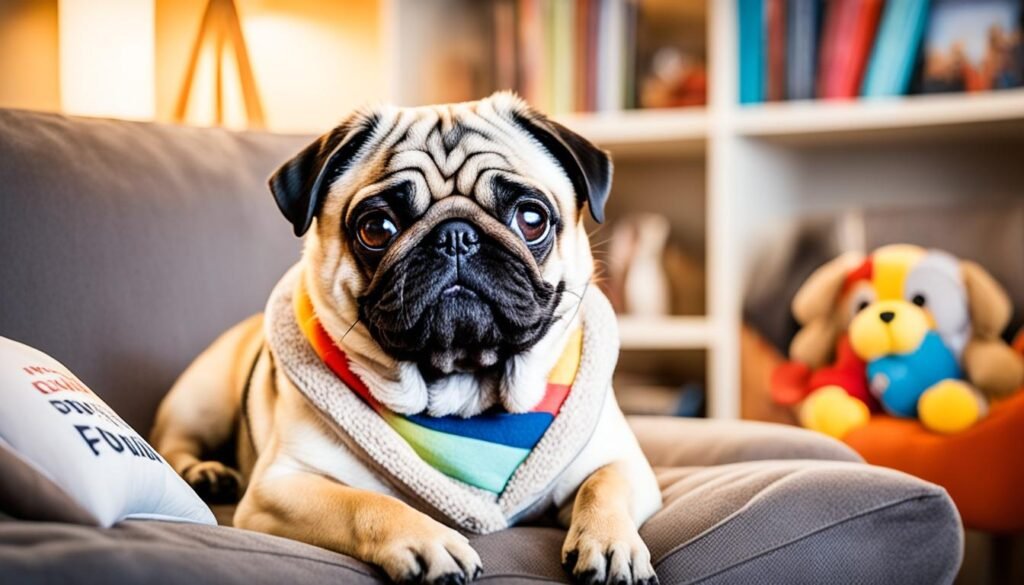Pug vs Labrador Retriever: Which Is the Best Family Dog?
Did you know that about 68% of American households have a pet, with dogs leading the pack? This rise in dog ownership raises a key question: which breed is ideal for families? In this piece, I’ll explore the Pug vs Labrador Retriever debate to aid in finding your family’s perfect canine companion. Both breeds are beloved for their unique qualities and adaptability, making them top choices for families. I aim to simplify their characteristics, helping you choose based on your family’s lifestyle and needs.
Understanding Dog Breeds for Families
As a dog lover, I know how important it is for families to understand dog breeds before getting a new pet. Each breed has its own temperament, size, and needs for grooming and exercise. For families with kids, knowing these things helps pick the right dog.
When looking for child-friendly pets, I check how well a breed gets along with kids. Some dogs are more patient and adaptable, making them great for families with young ones. The size and energy level of a dog also matter a lot. For example, big breeds like Labradors need lots of room to play.
Smaller breeds might be easier to handle but need careful thought about safety around little kids.
- Temperament affects how dogs react to children and other pets.
- Size determines how a dog interacts within the family space.
- Grooming needs dictate the level of maintenance required.
- Exercise requirements play a crucial role in a family’s lifestyle.
Understanding dog breeds helps families pick pets that fit their lifestyle and values. This way, everyone, especially the kids, gets a safe and loving home.
Meet the Labrador Retriever
The Labrador Retriever is often seen as one of the best family dogs. They are known for being friendly and smart. These large dogs are perfect for families of all sizes because they are loyal and loving. They weigh between 55-80 pounds and are 21.5-24.5 inches tall.
Labrador Retriever Traits
Labrador Retrievers are great for active families. They love to play and be outside. Here are some reasons why people love them:
- Affectionate nature: They love being around people and make great companions.
- Intelligence: They are smart and easy to train, which makes them great in many roles.
- Adaptability: Even though they like a lot of space, they can live in different homes as long as they get enough exercise.
Labrador’s Ideal Family Environment
A Labrador Retriever needs a lot of space and regular exercise to be happy. They do best in homes with yards for them to play in. Daily exercise of about an hour keeps them healthy and happy. Here’s what makes a good home for a Labrador:
- Space to run and play, which is good for their health.
- Time with people and other pets, which helps them stay friendly.
- Fun activities that keep their minds sharp and strengthen their bond with the family.

Discovering the Pug
Pugs are charming pets with delightful personalities and unique looks. They weigh 14-18 pounds and are 10-13 inches tall. This small dog breed has a lot of character in a compact size. Their flat faces and playful nature make them great for families, especially those with kids.
Pug Characteristics
Pugs are a lively mix of playful and affectionate. They are very loyal and always up for fun or cuddles. Their faces show many emotions, creating a strong bond with family.
These dogs love to be with their family and join in on activities. They make great pets for those looking for a loving companion.
Pug’s Adaptability to Family Life
Pugs are great for different living situations. They do well in both small apartments and big homes. They need about 30 minutes of exercise a day, fitting easily into a busy life.
They are very affectionate and fit well into family life. This makes them happy and brings joy to everyone.

Pug vs Labrador Retriever: Which Is the Best Family Dog?
Choosing a family dog is a big decision, especially when comparing Pugs and Labradors. Both have traits that fit different family needs. Knowing their characteristics helps in making the right choice for your family.
Energy Levels: Labradors are full of energy and love active homes. They need lots of playtime outside. Pugs, however, are calmer. They like short play times and then like to rest, perfect for families who want a quieter life.
Trainability: Training a dog is key, and Labradors are great at it. They’re smart and love to please, making training fun. Pugs can be stubborn but are loving and respond well to positive rewards, needing a special training method.
Temperament: Both breeds are loving and make great family pets. Labradors are friendly and love being around people, especially kids. Pugs are sweet and very loyal, forming strong family bonds.
Commitment Required: Both breeds need time and effort from their families. Labradors need lots of exercise and mental activities. Pugs don’t need as much exercise but still want attention and to be with their family.

Choosing between a Pug and a Labrador depends on your family’s lifestyle and what you want. Each breed adds its own special joys and challenges to family life. This makes the choice between Pugs and Labradors very important for those thinking of getting a dog.
Comparing Energy Levels and Exercise Needs
Finding the right dog means knowing their energy levels and exercise needs. Labradors and Pugs have different lifestyles that fit different families. Labradors need lots of exercise because they have a lot of energy. Pugs, however, need less exercise and are happy with a more relaxed routine.
Activity Requirements for Labradors
Labradors need a lot of exercise every day. They should get at least 60 minutes of activity. These dogs do well in active homes where they can stay busy physically and mentally.
My friend’s Labrador loves:
- Long walks in the park
- Playing fetch in the backyard
- Participating in dog sports and agility training
These activities help them use up their energy. It’s very important for these dogs to exercise to avoid bad behavior from being bored or having too much energy.
Exercise Levels for Pugs
Pugs don’t need as much exercise as Labradors. They usually need about 30 minutes of moderate activity daily. My Pug likes doing things like:
- Short walks around the neighborhood
- Playtime indoors with toys
- Casual playdates with other dogs
This makes Pugs great for families who want a less busy life. They fit well in homes without big yards or lots of time for exercise.
Grooming and Maintenance Requirements
Keeping our furry friends well-groomed is key to their health. Both Labradors and Pugs need special grooming based on their lifestyles.
Labrador Grooming Needs
Labradors have short, dense coats that need regular care. Brushing them often helps with shedding, especially in spring and fall. Here are some dog care tips for their coats:
- Brush at least once a week, using a slicker brush or grooming mitt.
- Schedule routine baths every month to keep their coat clean.
- Check their ears, eyes, and nails regularly to maintain overall health.
Pug Grooming Tips
Pugs need a special grooming routine. Their smooth coat doesn’t need as much brushing as a Labrador’s. But, it’s important to keep their facial wrinkles clean to avoid skin problems. Here are some tips for caring for Pugs:
- Gently clean their facial folds regularly with a damp cloth.
- Brush their coat occasionally to manage shedding.
- Trim their nails as needed, typically every few weeks.
Evaluating the Right Fit for Your Family
Finding the right dog means looking at your family’s lifestyle and needs. I learned that knowing the traits of different dogs can help a lot. For example, Labradors do well in homes where they can play and exercise a lot. Pugs, on the other hand, are okay with less activity.
It’s also key to think about your home size and outdoor space. If you have a small home or little outdoor space, a Pug might be better because they need less exercise. But if you have a big house and lots of space, a Labrador could be great because they love to run and play.
Choosing the right dog is about more than just the breed. It’s about how well the dog fits your family’s life. By thinking about what you need and what your family likes, you can pick a dog that will make everyone happy. This way, you’ll have a great relationship with your new pet.

